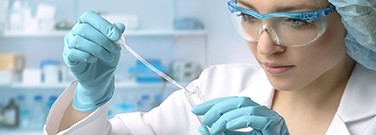Clinical Laboratory Careers

By Kylie Wolfe
Clinical or medical laboratories are staffed by scientists and technicians specifically trained to perform diagnostic testing and procedures to help physicians determine the appropriate patient care and treatment. These include:
- Examining and analyzing bodily fluids, cells, and tissues
- Identifying infective microorganisms
- Analyzing the chemical constituents of body fluids
- Identify blood-clotting abnormalities and monitoring therapeutics
- Typing and crossmatching blood for transfusions
- Evaluating circulating blood and bone marrow samples
- Measuring blood levels of therapeutic drugs and drugs of abuse
Medical Laboratory Technicians (MLTs) and Medical Laboratory Scientists (MLSs)
Medical laboratory technicians (MLTs) have two-year associate degrees from an approved program, while medical laboratory scientists (MLS) have bachelor’s degrees, also from accredited institutions. As of January 2022, there are 237 accredited MLT programs and 242 accredited MLS programs.
Although direct contact with patients is typically limited to phlebotomy (blood specimen collection), MLTs and MLSs both perform testing using manual techniques and biomedical equipment and instruments. Since MLSs have additional training and theoretical knowledge, they usually perform the more complicated testing procedures.
Employment Opportunities
The following organizations most often require the services of an MLT or MLS:
- Hospital and clinic laboratories
- Commercial or reference clinical laboratories
- Public health laboratories
- Forensic and law enforcement laboratories
- Veterinary clinics
In addition, the same laboratory skills are useful in:
- Pharmaceutical or chemical industries
- Biotechnology companies
- Research and teaching institutions
- Food and cosmetics industries
- Water and wastewater testing
Work Environment
Most hospital and reference laboratories operate 24 hours a day and seven days a week, which offers options for variability and flexibility in working shifts. Much of the work time is spent standing.
Laboratorians are regularly exposed to blood and bodily fluids, infectious diseases, chemical hazards, needles and other sharps, and other mechanical injury hazards.
Licensure and Certification
State licensing requirements vary and may not be required. Contact the specific state certification board or licensing agency for more information.
Both certified MLTs and MLSs must take specific steps to maintain their certification. In addition, ASCP-certified MLSs have continuing education requirements.
Job Outlook and Salaries
The Bureau of Labor Statistics (BLS) forecasts a faster than average growth of jobs: 11 percent (MLT) to 17 percent (MLS) between 2020 to 2030.
As of September 2021, there were 335,500 MLTs and 133,900 MLSs working in the U.S. These jobs are projected to increase by 36,500 for MLTs and 22,600 for MLSs by 2030.
The BLS reported average annual wages of $55,990 (MLT) and $101,800 (MLS) in May 2020. Self-reported salaries (January 2022) were somewhat lower: $43,093 (MLT) and $82,191 (MLS).
Opportunities for Advancement
MLTs may have to continue their education to be a laboratory supervisor. MLSs are more likely to act as consultants to physicians and researchers, integrate data, solve problems, conduct research, evaluate new test methods, train new hires, and advance to management positions.
How Can I Prepare Myself?
Take high school courses in biology, chemistry, math, physics, and other sciences. Look for volunteer opportunities in laboratories and investigate the available educational programs and their admission requirements.
To learn more about MLS/MLT careers, visit:
| Medical Laboratory Technician (MLT) | Medical Laboratory Scientist (MLS) | |
|---|---|---|
| Number Practicing in U.S. (BLS, Sept. 2021) | 335,500 ‘clinical laboratory technicians and technologists’ | 133,900 ‘medical scientists.’ |
| Expected Job Growth from 2020 to 2030 (BLS) | 11% | 17% |
| New Positions by 2030 | 36,500 | 22,600 |
| Salaries: BLS, May 2020 | $55,990 | $101,800 |
| Salaries: PayScale, Jan. 2022 | $43,093 (1,315 self-reports) | $82,191 (54 self-reports) |
| Degree Requirements (BLS, 2021) | Postsecondary certificate or associate degree | Bachelor’s degree |
| Degrees Available |
|
|
| Program Details | Courses: blood banking, clinical chemistry, hematology, and microbiology Other: equipment and technology, safety standards, diagnostic testing Laboratory settings: skills practice and proficiency | Courses: Same as associate degree plus anatomy, biochemistry, chemistry, immunology, and math Laboratory settings: In-person rotation during senior year mentored by an MLS |
| School Accreditation | The National Accrediting Agency for Clinical Laboratory Scientists (NAACLS) | The National Accrediting Agency for Clinical Laboratory Scientists (NAACLS) |
| Number of Programs (Jan. 2022) | 237 Click here to search for NAACLS-accredited MLT schools | 242 Click here to search for NAACLS-accredited MLS programs |
| Certifying Exams |
ASCP specialized MLT certifications:
|
MLS certifications:
|
| Licensing/Certification | State licensing requirements vary; not required by all | State licensing requirements vary; not required by all; may include:
|
| Licensing Agency | Students can find links to state licensure agencies for MLTs here | Students can find links for state licensing requirements for MLSs here |
| Re-Certification and Re-Licensing | Contact state certification board or licensing agency ASCP-certified MLTs must take specific steps to maintain certification every three years | Contact initial certification board or state licensing agency ASCP-certified MLSs must track continuing education through the |
| Job Responsibilities |
|
|
| Tools and Equipment |
| MLT tools plus:
|
| Opportunities for Specialization/Advancement | Requires additional training and education Certification may be required or preferred by employers |
|